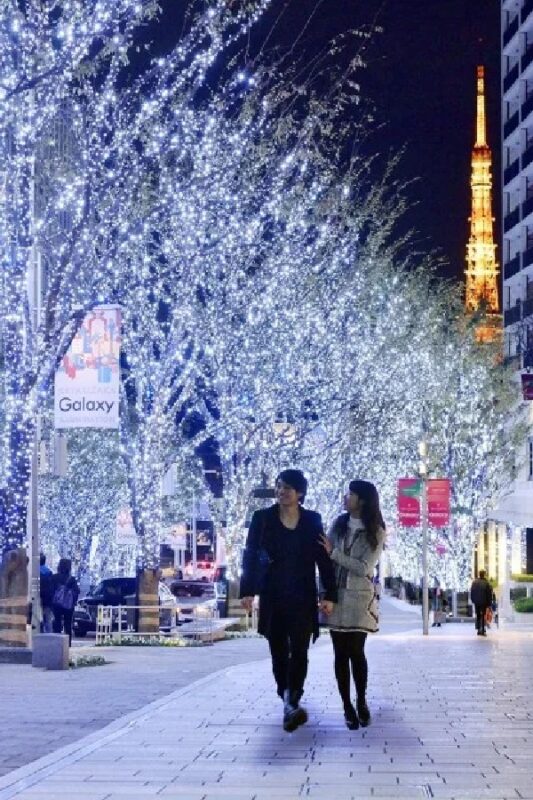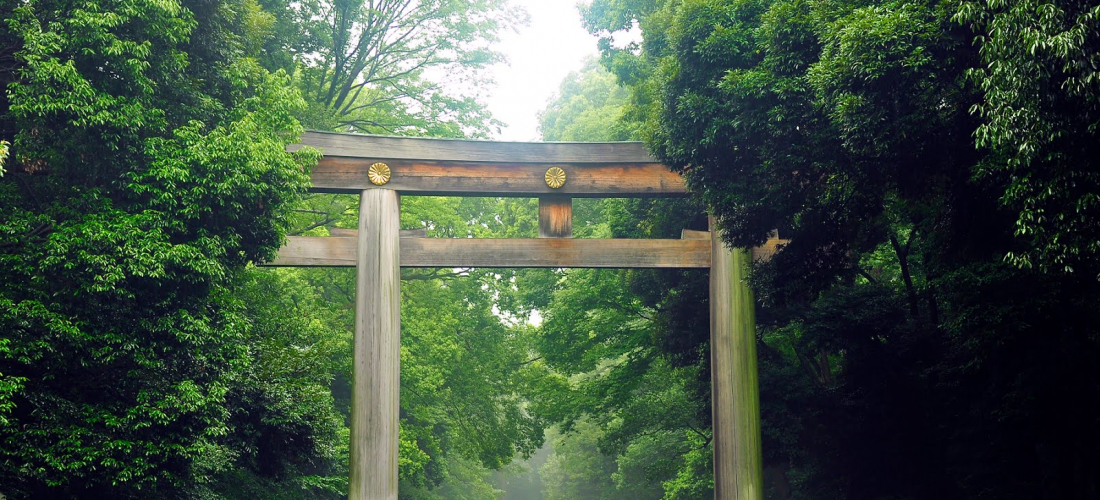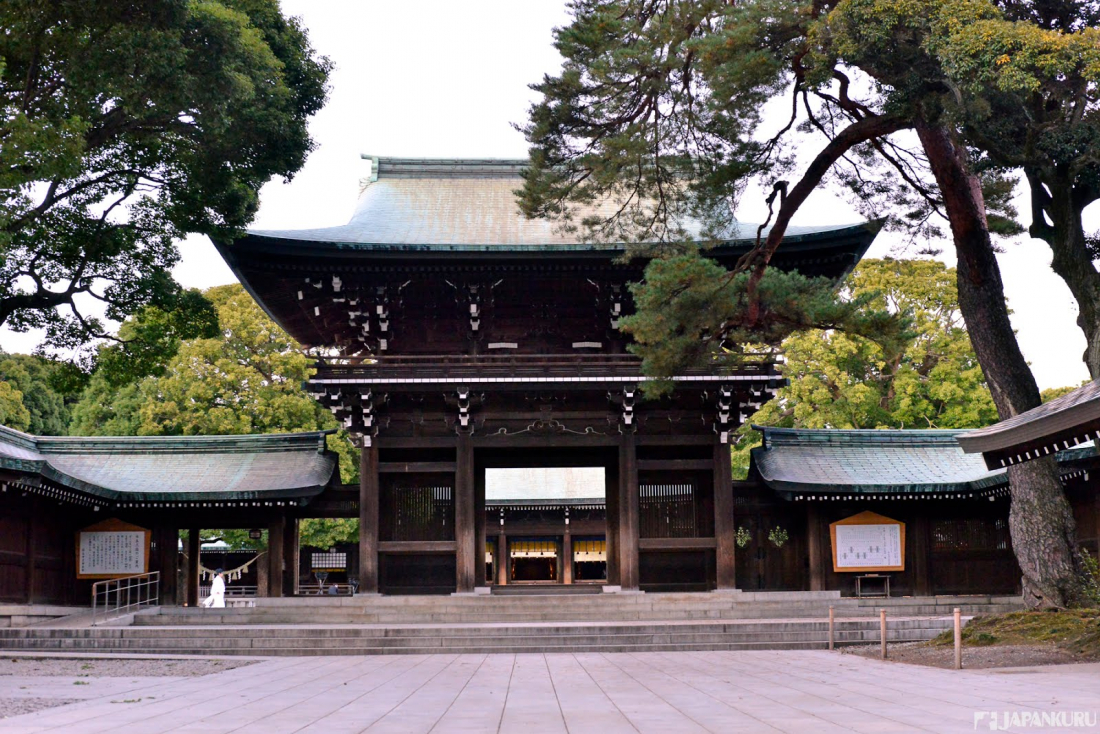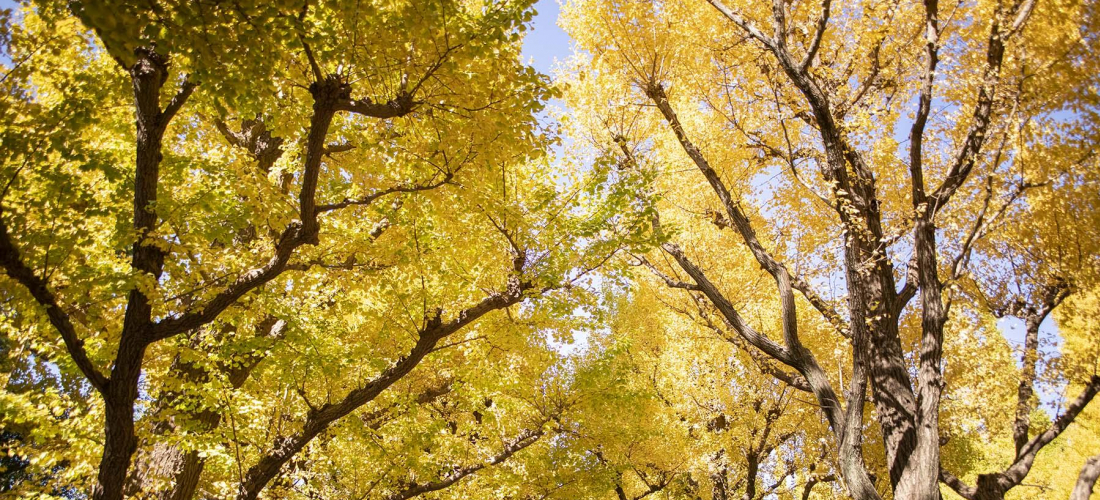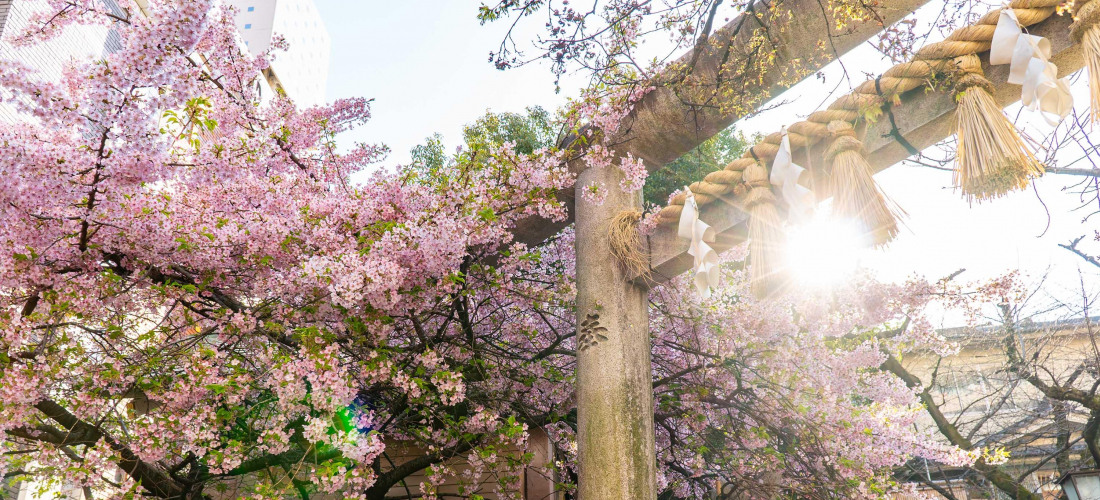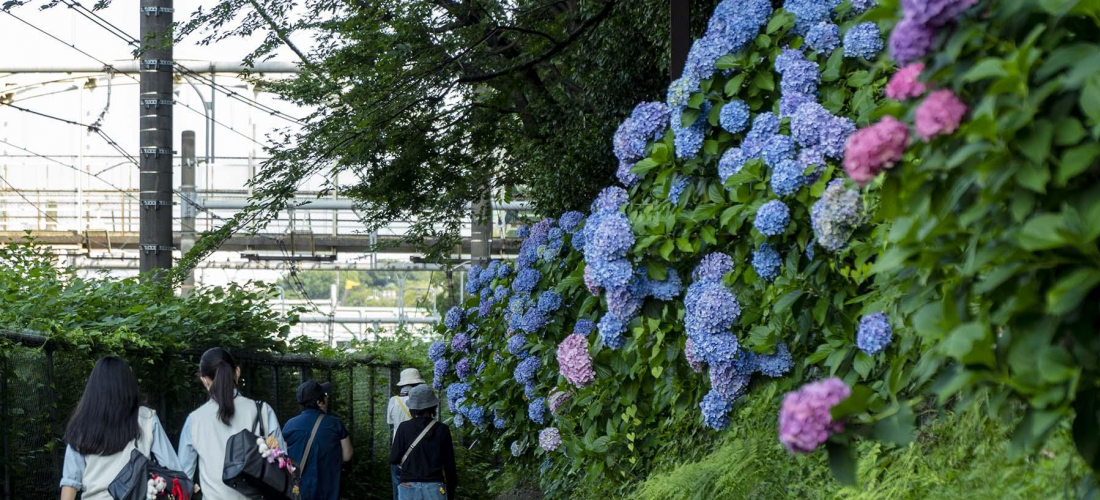CONTENTS
Tokyo’s most famous shrine can be found right in Shibuya, next to busy Harajuku, but the quiet atmosphere is like another world.
Entering the Shrine of the Meiji Emperor
Tokyo is a city filled with grey concrete, busy streets, and gleaming highrises, so it may come as a surprise to find one of Tokyo's more popular sightseeing attractions at the center of a quiet urban forest. The Meiji Jingu Shrine was constructed in the heart of Shibuya in the early 1900s, to honor and enshrine the deified spirits of the deceased Emperor Meiji (1852-1912) and his wife Empress Shoken (1849-1914). And while the Shibuya of a hundred years ago wasn't quite the bustling entertainment district it is today, the area surrounding the shrine certainly wasn't a wooded patch of countryside at the time, either. The modern-day parkland that provides a serene home for the shrine halls was built up through a massive nationwide effort with contributions from every prefecture, including 110,000 young volunteers who donated their time and energy to plant 120,000 trees collected from all over Japan and overseas. Over the past century, this unique little forest has grown tall with shady canopies that shield the shrine grounds from the noise and crowds of Harajuku, a neighborhood that has sprouted up equally boldly just beyond the Meiji Jingu gates.
Entering a cleft in the thick grove of trees and stepping onto the bumpy gravel path, the first sign that this is no ordinary park comes from a tall shrine gate, stained green by years of moss and lichens. This Japanese shrine gate, often referred to by the Japanese name "torii" (鳥居), marks the entrance to Meiji Jingu Shrine. But more importantly, the torii marks the boundary between our world and the sacred realm of the gods. Outside, the hustle and bustle of Harajuku encourages each individual to think about themselves and their more concrete desires, but the holy shrine grounds are a place to look at the bigger picture. When passing under the gate and intruding on the Shinto gods' territory, it's not unusual to see Japanese people bow upon entering or leaving, as a sign of respect.
Outside this unique green space, the steel skyscrapers of Shibuya block out the sky with their immovable bulk.
Inside the shrine, the souls of Emperor Meiji and Empress Shoken are said to reside within each and every one of the trees planted by young Japanese volunteers a century past. To some, the thick green canopy overhead might feel like the protective embrace of Japan's former rulers, shading visitors from the sun and rain. Others might better appreciate the real, practical protection that this parkland provides for many Japanese plants and animals. The hand-planted trees are such an enduring part of the landscape that the shrine grounds have become a refuge for a number of endangered species.
The most eye-catching landmark on the Meiji Jingu path is the wall of sake barrels displayed on the side of the road. These barrels are sometimes found at Shinto shrines, and they harken back to the long-held connection between sake and Japan's indigenous religion. The ancient Japanese word for sake was "miki" (神酒), which can be somewhat poetically translated as "alcohol of the gods." Thus, sake has long been a part of Shinto rituals and celebrations, as an offering and a part of ceremonies, where it's still referred to as "miki" to this day. The sake for those ceremonies is donated by breweries around Japan, and the breweries receive prayers for prosperity from the shrine in return. But sake lovers may be sad to hear that the barrels at Meiji Jingu Shrine aren't actually full of alcohol. They're called "kazaridaru" (飾り樽), which literally means "decorative barrels."
What's less common at Shinto shrines is European-style grape wine barrels!
The Meiji period (1868-1912), when Emperor Meiji ruled over Japan, marked a dramatic change for the country. Gone were the days of samurai rule and isolationist thinking – the new emperor embraced industrialization and foreign cultures, putting it in his own words as a poem:
"By gaining the good and rejecting what is wrong, it is our desire that we'll compare favorably with other lands abroad."
Reflecting the many cosmopolitan changes that Emperor Meiji brought to his country, the words of this poem can now be read in front of dozens of Bourgogne wine casks (from Burgundy), donated to the shrine in his honor.
To the Shrine Halls
Meiji Jingu Shrine was established in the 20th century, but one thing it shares with much, much older Shinto shrines (like the allegedly 2,600-year-old Katori Shrine) is a distinct difference between the age of the shrine and the age of the buildings. It's not uncommon for a historic building in Japan, like a shrine or temple, to be reconstructed many times during its long history, and for Meiji Jingu that means the shrine halls were largely rebuilt in the 1940s and '50s, after being damaged during the Tokyo air raids of World War II. The modern-day buildings aren't exactly the same as the originals, but they do share some of the traditional architecture still common among Shinto shrines.
Before approaching the main hall of any shrine, one last important stop is the chozuya or temizuya (手水舎), for purification. These fountains of flowing water come in many shapes and sizes, but they all serve the same purpose – for shrine visitors to cleanse their bodies before praying to the gods. During covid times, many chozuya were roped off or altered to comply with safety measures, despite being symbols of hand washing. The traditional chozuya ritual is more about spiritual cleansing and less about killing germs, which was less than ideal during a pandemic.
To use a chozuya the traditional way, take a ladle in your right hand and fill it from the fountain's flowing water. Pour a little of the water on your left hand, switch hands to pour a little water on your right hand, then move the ladle back to your right hand. Pour a little of the water into your cupped left hand, then raise your hand to your mouth to gently "rinse it" before carefully spitting the excess water out onto the ground. Finally, let whatever water is left in the ladle trickle down the handle to rinse it off for the next person, before returning the ladle to its resting place. If you find yourself forgetting the steps, just keep an eye out for old ladies, who usually know what they're doing.
The shrine's main hall lies at the end of the path, enshrining the spirits of Emperor Meiji and Empress Shoken, although the actual mausoleum that serves as their final resting place is far to the west in Kyoto. Here, visitors line up to toss a coin in the offering box (5 yen is the standard in Japan), and pray to the deified rulers, asking them for a little extra luck, or thanking them for all their good fortune. To pray, bow twice, then clap your hands twice, make your prayers, and then bow once more. This is different from praying at a Buddhist temple, where you can simply bring your hands gently together to pray!
Traditional etiquette states that those with open wounds and infections, or those in mourning should avoid visiting Shinto shrines, as those particular conditions are considered "impure." But really, there's no excuse not to visit Meiji Jingu! Visit to see the shrine's many yearly events and ceremonies, check out the Meiji Jingu Museum and the iris garden, and keep an eye out for traditional Shinto weddings while you're there!
For more info and updates from Japan, check Japankuru for new articles, and don't forget to follow us on Twitter, Instagram, and Facebook!
Details
NAME:Meiji Jingu Shrine (明治神宮)
ACCESS:Harajuku Station
COMMENT
FEATURED MEDIA
VIEW MORE 
A New Tokyo Animal Destination: Relax & Learn About the World’s Animals in Japan
#pr #japankuru #anitouch #anitouchtokyodome #capybara #capybaracafe #animalcafe #tokyotrip #japantrip #카피바라 #애니터치 #아이와가볼만한곳 #도쿄여행 #가족여행 #東京旅遊 #東京親子景點 #日本動物互動體驗 #水豚泡澡 #東京巨蛋城 #เที่ยวญี่ปุ่น2025 #ที่เที่ยวครอบครัว #สวนสัตว์ในร่ม #TokyoDomeCity #anitouchtokyodome

Shohei Ohtani Collab Developed Products & Other Japanese Drugstore Recommendations From Kowa
#pr #japankuru
#kowa #syncronkowa #japanshopping #preworkout #postworkout #tokyoshopping #japantrip #일본쇼핑 #일본이온음료 #오타니 #오타니쇼헤이 #코와 #興和 #日本必買 #日本旅遊 #運動補充能量 #運動飲品 #ช้อปปิ้งญี่ปุ่น #เครื่องดื่มออกกำลังกาย #นักกีฬา #ผลิตภัณฑ์ญี่ปุ่น #อาหารเสริมญี่ปุ่น

도쿄 근교 당일치기 여행 추천! 작은 에도라 불리는 ‘가와고에’
세이부 ‘가와고에 패스(디지털)’ 하나면 편리하게 이동 + 가성비까지 완벽하게! 필름카메라 감성 가득한 레트로 거리 길거리 먹방부터 귀여움 끝판왕 핫플&포토 스폿까지 총집합!
Looking for day trips from Tokyo? Try Kawagoe, AKA Little Edo!
Use the SEIBU KAWAGOE PASS (Digital) for easy, affordable transportation!
Check out the historic streets of Kawagoe for some great street food and plenty of picturesque retro photo ops.
#pr #japankuru #도쿄근교여행 #가와고에 #가와고에패스 #세이부패스 #기모노체험 #가와고에여행 #도쿄여행코스 #도쿄근교당일치기 #세이부가와고에패스
#tokyotrip #kawagoe #tokyodaytrip #seibukawagoepass #kimono #japantrip

Hirakata Park, Osaka: Enjoy the Classic Japanese Theme Park Experience!
#pr #japankuru #hirakatapark #amusementpark #japantrip #osakatrip #familytrip #rollercoaster #retrôvibes #枚方公園 #大阪旅遊 #關西私房景點 #日本親子旅行 #日本遊樂園 #木造雲霄飛車 #히라카타파크 #สวนสนุกฮิราคาตะพาร์ค

🍵Love Matcha? Upgrade Your Matcha Experience With Tsujiri!
・160년 전통 일본 말차 브랜드 츠지리에서 말차 덕후들이 픽한 인기템만 골라봤어요
・抹茶控的天堂!甜點、餅乾、飲品一次滿足,連伴手禮都幫你列好清單了
・ส่องมัทฉะสุดฮิต พร้อมพาเที่ยวร้านดังในอุจิ เกียวโต
#pr #japankuru #matcha #matchalover #uji #kyoto #japantrip #ujimatcha #matchalatte #matchasweets #tsujiri #말차 #말차덕후 #츠지리 #교토여행 #말차라떼 #辻利抹茶 #抹茶控 #日本抹茶 #宇治 #宇治抹茶 #日本伴手禮 #抹茶拿鐵 #抹茶甜點 #มัทฉะ #ของฝากญี่ปุ่น #ชาเขียวญี่ปุ่น #ซึจิริ #เกียวโต

・What Is Nenaito? And How Does This Sleep Care Supplement Work?
・你的睡眠保健品——認識「睡眠茶氨酸錠」
・수면 케어 서플리먼트 ‘네나이토’란?
・ผลิตภัณฑ์เสริมอาหารดูแลการนอน “Nenaito(ネナイト)” คืออะไร?
#pr #japankuru #sleepcare #japanshopping #nenaito #sleepsupplement #asahi #睡眠茶氨酸錠 #睡眠保健 #朝日 #l茶胺酸 #日本藥妝 #日本必買 #일본쇼핑 #수면 #건강하자 #네나이토 #일본영양제 #อาหารเสริมญี่ปุ่น #ช้อปปิ้งญี่ปุ่น #ร้านขายยาญี่ปุ่น #ดูแลตัวเองก่อนนอน #อาซาฮิ

Japanese Drugstore Must-Buys! Essential Items from Hisamitsu® Pharmaceutical
#PR #japankuru #hisamitsu #salonpas #feitas #hisamitsupharmaceutical #japanshopping #tokyoshopping #traveltips #japanhaul #japantrip #japantravel

Whether you grew up with Dragon Ball or you just fell in love with Dragon Ball DAIMA, you'll like the newest JINS collab. Shop this limited-edition Dragon Ball accessory collection to find some of the best Dragon Ball merchandise in Japan!
>> Find out more at Japankuru.com! (link in bio)
#japankuru #dragonball #dragonballdaima #animecollab #japanshopping #jins #japaneseglasses #japantravel #animemerch #pr

This month, Japankuru teamed up with @official_korekoko to invite three influencers (originally from Thailand, China, and Taiwan) on a trip to Yokohama. Check out the article (in Chinese) on Japankuru.com for all of their travel tips and photography hints - and look forward to more cool collaborations coming soon!
【橫濱夜散策 x 教你怎麼拍出網美照 📸✨】
每次來日本玩,是不是都會先找旅日網紅的推薦清單?
這次,我們邀請擁有日本豐富旅遊經驗的🇹🇭泰國、🇨🇳中國、🇹🇼台灣網紅,帶你走進夜晚的橫濱!從玩樂路線到拍照技巧,教你怎麼拍出最美的夜景照。那些熟悉的景點,換個視角說不定會有新發現~快跟他們一起出發吧!
#japankuru #橫濱紅磚倉庫 #汽車道 #中華街 #yokohama #japankuru #橫濱紅磚倉庫 #汽車道 #中華街 #yokohama #yokohamaredbrickwarehouse #yokohamachinatown

If you’re a fan of Vivienne Westwood's Japanese designs, and you’re looking forward to shopping in Harajuku this summer, we’ve got important news for you. Vivienne Westwood RED LABEL Laforet Harajuku is now closed for renovations - but the grand reopening is scheduled for July!
>> Find out more at Japankuru.com! (link in bio)
#japankuru #viviennewestwood #harajuku #omotesando #viviennewestwoodredlabel #viviennewestwoodjapan #비비안웨스트우드 #오모테산도 #하라주쿠 #日本購物 #薇薇安魏斯伍德 #日本時尚 #原宿 #表參道 #japantrip #japanshopping #pr

Ready to see TeamLab in Kyoto!? At TeamLab Biovortex Kyoto, the collective is taking their acclaimed immersive art and bringing it to Japan's ancient capital. We can't wait to see it for ourselves this autumn!
>> Find out more at Japankuru.com! (link in bio)
#japankuru #teamlab #teamlabbiovortex #kyoto #kyototrip #japantravel #artnews
Photos courtesy of teamLab, Exhibition view of teamLab Biovortex Kyoto, 2025, Kyoto ® teamLab, courtesy Pace Gallery

Japanese Makeup Shopping • A Trip to Kamakura & Enoshima With Canmake’s Cool-Toned Summer Makeup
#pr #canmake #enoshima #enoden #에노시마 #캔메이크 #japanesemakeup #japanesecosmetics

⚔️The Robot Restaurant is gone, but the Samurai Restaurant is here to take its place. Check it out, and don't forget your coupon!
🍣신주쿠의 명소 로봇 레스토랑이 사무라이 레스토랑으로 부활! 절찬 쿠폰 발급중
💃18歲以上才能入場的歌舞秀,和你想的不一樣!拿好優惠券去看看~
#tokyo #shinjuku #samurairestaurant #robotrestaurant #tokyotrip #도쿄여행 #신주쿠 #사무라이레스토랑 #이색체험 #할인이벤트 #歌舞伎町 #東京景點 #武士餐廳 #日本表演 #日本文化體驗 #japankuru #japantrip #japantravel #japanlovers #japan_of_insta

Japanese appliance & electronics shopping with our KOJIMA x BicCamera coupon!
用JAPANKURU的KOJIMA x BicCamera優惠券買這些正好❤️
코지마 x 빅 카메라 쿠폰으로 일본 가전 제품 쇼핑하기
#pr #japankuru #japanshopping #kojima #biccamera #japaneseskincare #yaman #dji #osmopocket3 #skincaredevice #日本購物 #美容儀 #相機 #雅萌 #日本家電 #일본여행 #면세 #여행꿀팁 #일본쇼핑리스트 #쿠폰 #일본쇼핑 #일본브랜드 #할인 #코지마 #빅카메라 #japankurucoupon
MAP OF JAPAN
SEARCH BY REGION

LATEST
VIEW MOREEVENT CALENDAR
VIEW MORE
